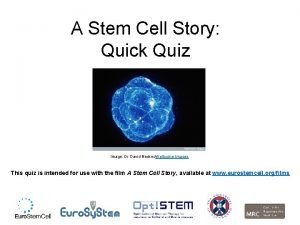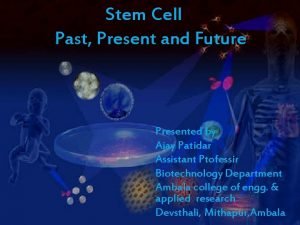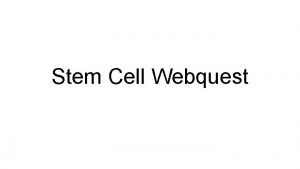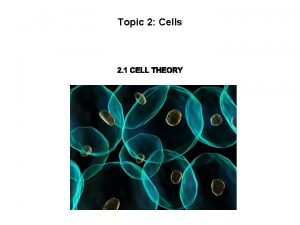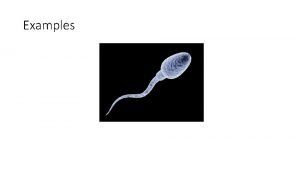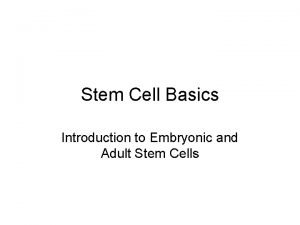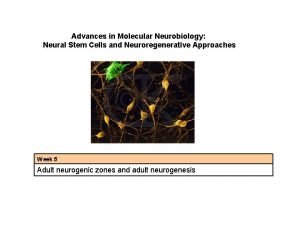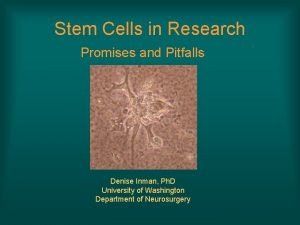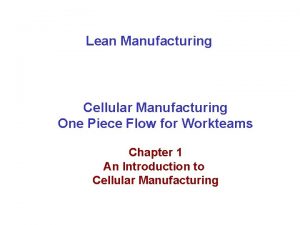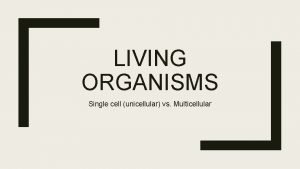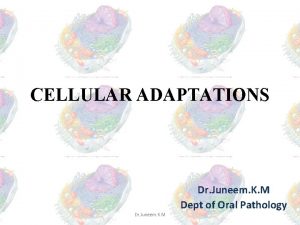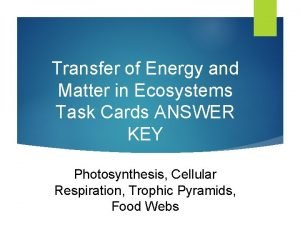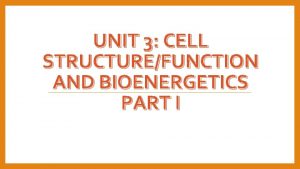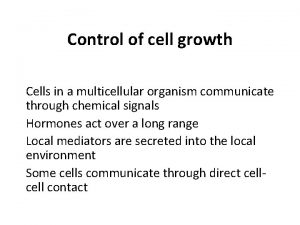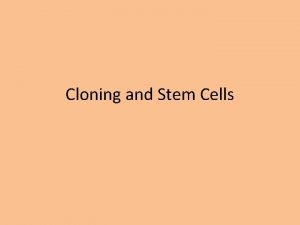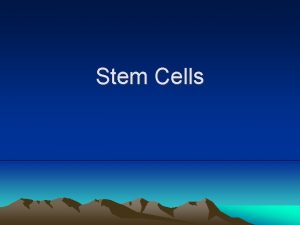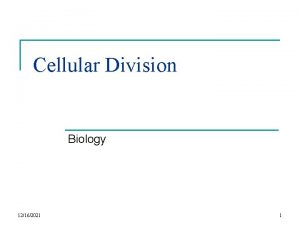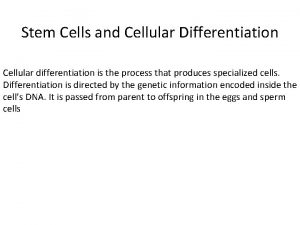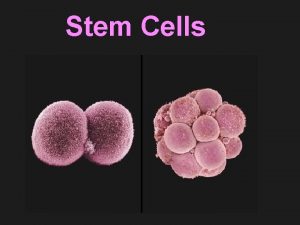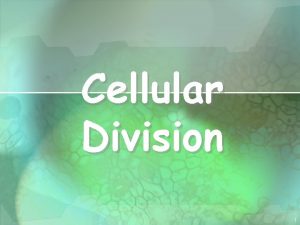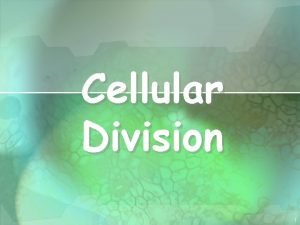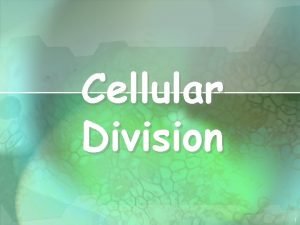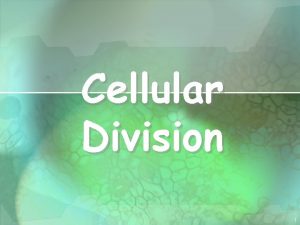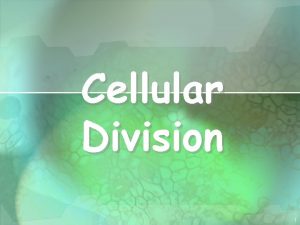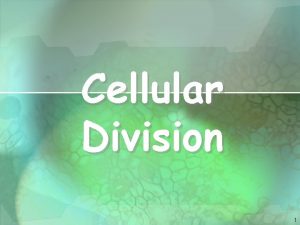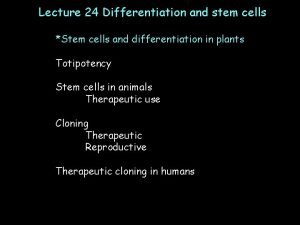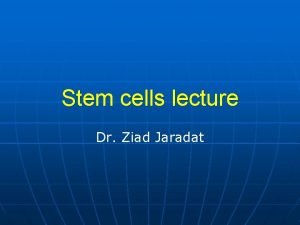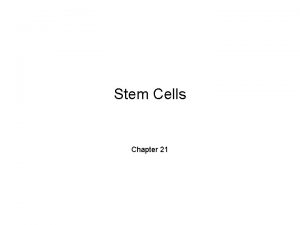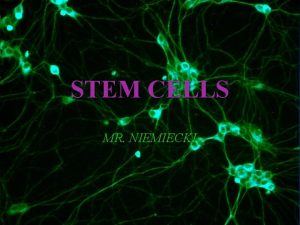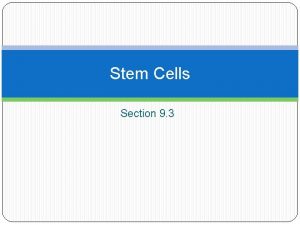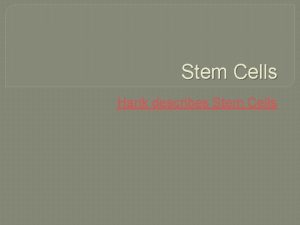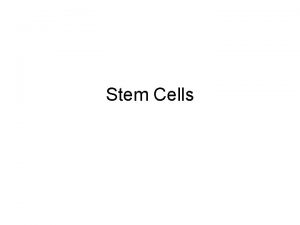CELLULAR DIVISION Stem Cells What Are Stem Cells







































- Slides: 39

CELLULAR DIVISION Stem Cells

What Are Stem Cells? �Stem cells are the source, or “stem”, for all of the specialized cells that form our organs and tissues. �Your body contains over 200 types of cells �blood cells carry oxygen �muscle cells contract so that you can move �nerve cells transmit chemical signals �The job of a stem cell is to make new cells.

HOW? �It does this by undergoing an amazing process differentiating, or changing into another type of cell. �Each time a stem cell divides, one of the new cells might remain a stem cell while the other turns into a heart, blood, brain, or other type of cell. �In fact, stem cells are able to divide to replenish themselves and other cells without any apparent limit.


Stem Cell History �Scientists discovered ways to derive embryonic stem cells from early mouse embryos more than 30 years ago, in 1981. �In 1998 the detailed study of the biology of mouse stem cells led to the discovery of a method to derive stem cells from human embryos and grow the cells in the laboratory.

Stem Cells

Types of Stem Cells �There are many kinds of stem cells, but two types have made frequent appearances in the news: �embryonic stem cells (ES) �somatic stem cells (adult stem cells)

Embryonic Stem Cells �present in very early—and very tiny— embryos �produce the first cells of the heart, brain, and other organs. �have the potential to form just about any other cell in the body.

Zygote - (fertilization took place)

Early Cell Division Source: Florida Institute for Reproductive Science and Technologies

Four-cell stage 2 days after fertilization Source: Florida Institute for Reproductive Science and Technologies

Eight-cell stage 3 days after fertilization Courtesy: RWJMS IVF Program Source: Florida Institute for Reproductive Science and Technologies

Morula (ball of cells) 4 days after fertilization 16 cells Source: Florida Institute for Reproductive Science and Technologies

Blastula (earliest stage of embryo) 5 days after fertilization Source: Florida Institute for Reproductive Science and Technologies Courtesy: RWJMS IVF Program

Blastula (Blastocyst) (hollow ball of cells making embryo) This image has been released into the public domain.

Adult Stem Cells �Adult stem cells can replenish some tissues lost through normal wear and tear or injury. �However, adult stem cells are only able to generate a few specific cell types. �adult stem cells in bone marrow, for example, make new blood cells, �adult stem cells in the skin make the cells that replenish layers of the skin.


Types of Stem Cells

�Totipotent stem cells �one of the most important stem cells types because they have the potential to develop into any cell found in the human body �“whole” �Pluripotent stem cells �which can go on to specialize further but can't ever produce an entire organism. �“many”

�Multipotent Stem Cells �Develop multiple, organ specific cell types. �“several” �Unipotent stem cells �a cell that can differentiate along only one lineage. �the word 'uni' itself is derived from the Latin word 'unus, ' meaning one. �found in adult tissues �has the capacity to differentiate into only one type of cell or tissue


Induced Pluripotent Stem Cells �Induced pluripotent stem (i. PS) cells are created artificially in the lab by "reprogramming" a patient's own cells. �i. PS cells can be made from readily available cells including fat, skin, and fibroblasts (cells that produce connective tissue).


• Since i. PS cells can be made from a patient's own cells, there is no danger that their immune system will reject them. • i. PS cells are much less expensive to create than ES • However, because the "reprogramming" process introduces genetic modifications, the safety of using i. PS cells in patients is uncertain.

Stem Cells: Cells With Potential

Where are Stem Cells Located? �Adult stem cells have been identified in many organs and tissues, including � brain � bone marrow � peripheral blood � blood vessels � skeletal muscle � skin � teeth � heart � gut � liver � ovarian epithelium � testis.

Cord blood �Once discarded as medical waste, cord blood is the small volume of blood that’s left in the umbilical cord after birth. �rich sources of stem cells in the body, due to the type of stem cells it contains �has long been used in the treatment of many blood diseases, including anemia, leukemia, myelodysplasia, and lymphoma. �$3000 upfront $150/year

Teeth �In the early 2000 s, around 20 years after they were discovered in umbilical cord blood, stem cells were found in our teeth.

Save a Tooth Upfront Cost Annual Cost Store – A - Tooth $1, 749 $120 The Tooth Bank $475 $115 Stem Save $630 $120


Why Important �Stem cells represent an exciting area in medicine because of their potential to regenerate and repair damaged tissue. �Some current therapies, such as bone marrow transplantation, already make use of stem cells and their potential for regeneration of damaged tissues.

Potential Treatments Include: �regenerating bone using cells derived from bone marrow stroma �developing insulin-producing cells for type 1 diabetes �repairing damaged heart muscle following a heart attack with cardiac muscle cells.

Stem Cell Story Stem Cell Medicine Stem Cell Heart

Stem Cell Quiz

Stem Cells �Private Funding �Public Funding

Parents have babies by means of in vitro fertilization. �After the fertilized eggs were examined, the best ones were implanted and the babies were born. �What should become of the other fertilized eggs. �Annual cost to “keep the others frozen” is $500 annually.

Ethics �Until recently, the only way to get pluripotent stem cells for research was to remove the inner cell mass of an embryo and put it in a dish. The thought of destroying a human embryo can be unsettling, even if it is only five days old.

Ethics �Stem cell research thus raised difficult questions: �Does life begin at fertilization, in the womb, or at birth? �Is a human embryo equivalent to a human child? �Does a human embryo have any rights? �Might the destruction of a single embryo be justified if it provides a cure for a countless number of patients? �Since ES cells can grow indefinitely in a dish and can, in theory, still grow into a human being, is the embryo really destroyed?

One Families Dilemma
 Antigentest åre
Antigentest åre Nondisjunction in meiosis
Nondisjunction in meiosis What is the missing number in the synthetic-division array
What is the missing number in the synthetic-division array Short and long division
Short and long division Synthetic division method
Synthetic division method 369 times 2
369 times 2 Where can scientists obtain stem cells? *
Where can scientists obtain stem cells? * Conclusion of stem cells
Conclusion of stem cells Stem cells webquest
Stem cells webquest Outline the cell theory
Outline the cell theory Pluripotent stem cells examples
Pluripotent stem cells examples Adult stem cells
Adult stem cells Stem cells specialization
Stem cells specialization Stem cells
Stem cells Classification of stem cells
Classification of stem cells Conclusion of stem cells
Conclusion of stem cells A biological process that occurs in plants
A biological process that occurs in plants Prokaryotic cells vs eukaryotic cells
Prokaryotic cells vs eukaryotic cells Papillary duct of bellini
Papillary duct of bellini Prokaryotic cells vs eukaryotic cells
Prokaryotic cells vs eukaryotic cells Chlorocruorin
Chlorocruorin The organelle trail
The organelle trail Pineal gland
Pineal gland Prokaryotic cell vs eukaryotic cell
Prokaryotic cell vs eukaryotic cell Prokaryotic vs eukaryotic cells
Prokaryotic vs eukaryotic cells Masses of cells form and steal nutrients from healthy cells
Masses of cells form and steal nutrients from healthy cells How are somatic cells different from gametes
How are somatic cells different from gametes Similarities between plant and animal cells venn diagram
Similarities between plant and animal cells venn diagram Submentovertical projection
Submentovertical projection Cells cells they're made of organelles meme
Cells cells they're made of organelles meme Label
Label Why dna is more stable than rna?
Why dna is more stable than rna? Lean cellular manufacturing
Lean cellular manufacturing Chapter 8 section 3: cellular respiration
Chapter 8 section 3: cellular respiration Non cellular particle
Non cellular particle Multi cellular organism
Multi cellular organism Cellular adaptation of growth and differentiation
Cellular adaptation of growth and differentiation Where does cellular respiration take place
Where does cellular respiration take place Cellular respiration modle
Cellular respiration modle Cellular adaptation of growth and differentiation
Cellular adaptation of growth and differentiation






